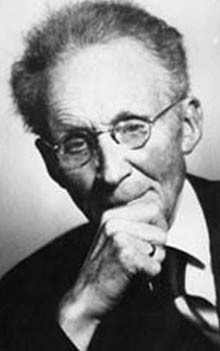-
(b.) -1862 March 14(d.)1951 April 09
Bio/Description
A Norwegian physicist and meteorologist who did much to found the modern practice of weather forecasting, Born in Christiania, he enjoyed an early exposure to fluid dynamics, as assistant to his father, Carl Anton Bjerknes, who had discovered by mathematical analysis the apparent actions at a distance between pulsating and oscillating bodies in a fluid, and their analogy with the electric and magnetic actions at a distance. When he was about 17 or 18 years of age, he demonstrated experimentally the theories arrived at by the older professor and turned his mathematical knowledge and mechanical abilities to the devising of a series of instruments by which all the well-known phenomena of electricity and magnetism were illustrated and reproduced by spheres and discs and membranes set into rhythmic vibration in a bath containing a viscous fluid such as syrup. These demonstrations formed the most important exhibit in the department of physics at the Exposition Internationale d'?lectricit? held in Paris in 1881, and aroused greatest interest in the scientific world. He became assistant to Heinrich Hertz in Bonn 1890-1891 and made substantial contributions to Hertz' work on electromagnetic resonance. He succeeded in giving the explanation of the phenomenon called ?multiple resonance,? discovered by Sarasin and De la Rive. Continuing his experiments at the University of Christiania (1891-1892), he proved experimentally the influence which the conductivity and the magnetic properties of the metallic conductors exert upon the electric oscillations, and measured the depth to which the electric oscillations penetrate in metals of different conductivity and magnetic permeability (the ?skin effect?). Finally, in 1895 he furnished a complete theory of the phenomenon of electric resonance, involving a method of utilizing resonance experiments for the determination of the wave lengths, and especially of the damping (the logarithmic decrement) of the oscillations in the transmitter and the receiver of the electric oscillations. These methods contributed much to the development of wireless telegraphy. His papers on electric oscillations were published in Annalen der Physik (1891-1895). In 1895, he became professor of applied mechanics and mathematical physics at the University of Stockholm where he had been lecturer since 1893. There he elucidated the fundamental interaction between fluid dynamics and thermodynamics. His major contribution was the primitive equations which are used in climate models. It was this work that inspired both V. Walfrid Ekman and Carl-Gustav Arvid Rossby to apply it to large-scale motions in the oceans and atmosphere and to make modern weather forecasting feasible. Bjerknes himself had foreseen the possible applications as early as 1904. This attack upon the meteorological problems from a hydrodynamical point of view was after 1906 supported by the Carnegie Institution of Washington, D.C., of which he became a research associate. Two introductory volumes, Statics and Kinematics, of a greater work, Dynamic Meteorology and Hydrography, were published in 1913 under the auspices of the Institution. In his Vorlesungen ?ber Hydrodynamische Fernkr?fte nach C. A. Bjerknes Theorie (1900-1902) he gave the first complete mathematical and experimental exposition of the discoveries of his father, and in a later book, Die Kraftfelder (1909), he stated the same theory in a very much generalized form according to methods of his own. In 1907, he returned to the The Royal Frederick University in Oslo before becoming professor of geophysics at the University of Leipzig in 1912. In 1916, he started the publication Synoptische Darstellung atmosph?rischer Zust?nde ?ber Europa. In 1917, he founded the Geophysical Institute, University of Bergen where he wrote his book On the Dynamics of the Circular Vortex with Applications to the Atmosphere and to Atmospheric Vortex and Wave Motion (1921), and laid the foundation for the Bergen School of Meteorology. He was the originator there of an improved and more scientific weather service, afterwards controlled by his son and collaborator, the meteorologist Jacob Bjerknes (1897-1975). From 1926 to his retirement in 1932 he held a position at the University of Oslo, where he died of heart problems. He was elected a member of the Royal Swedish Academy of Sciences in 1905. The crater Bjerknes on the Moon and a crater on Mars are named in his honor.
-
Date of Birth:
1862 March 14 -
Date of Death:
1951 April 09 -
Gender:
Male -
Noted For:
His experiments with electric oscillations contributed much to the development of wireless telegraphy -
Category of Achievement:
-
More Info:


